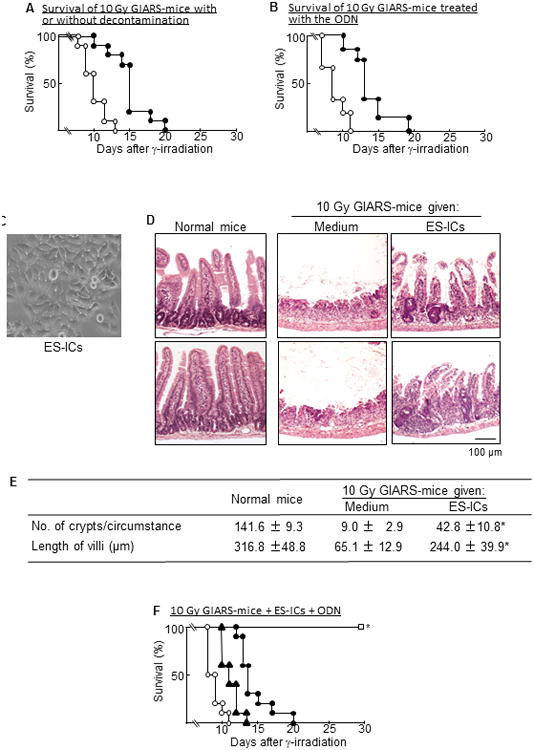Figure 4.

Gastrointestinal damages and antibacterial resistance of 10 Gy GIARS-mice. The survival of 10 Gy GIARS-mice (○) and dGIARS-mice (●) was monitored twice a day for 30 days (A). Data are representative of two independent experiments. Ten mice per group were used in each independent experiment. Ten Gy GIARS-mice were treated s.c. with 25 μg/mouse of CCL1 antisense ODN (●) or scrambled ODN (○) twice daily until end of experiments starting 3 days after the irradiation, and the survival of these mice was monitored twice daily for 30 days (B). Data are representative of two independent experiments. Fifteen mice per group were used in each independent experiment. ES-ILCs (C), differentiated from murine embryonic stem cells, were transplanted (2 × 106 cells/mouse, i.v.) to 10 Gy GIARS-mice 2 and 4 days post-irradiation. Light microscopic images (100× magnification) of the H&E ileum section were obtained from these mice 7 days post-irradiation (D). Data shown in C and D are representative of three independent experiments. Three mice per group were used in each independent experiment. Light microscopic images obtained in D were digitized, and the number of crypts per circumstance and the length of villi were measured 7 days post-irradiation by analySIS docu software (E). Data are shown as means ± SE. *p <0.001 versus GIARS-mice treated with media (Student's t test). (F) Ten Gy GIARS-mice were given ES-ICs alone (2 × 106 cells/mouse, i.v.) 2 and 4 days post-irradiation ▲, 25 μg/mouse of CCL1 antisense ODN alone (●), or both (□). Untreated 10 Gy GIARS-mice served as a control (●). The survival of these mice was monitored twice a day for 30 days. Data are representative of two independent experiments. Ten mice per group were used in each independent experiment. *p <0.001 versus control (log-rank test).
